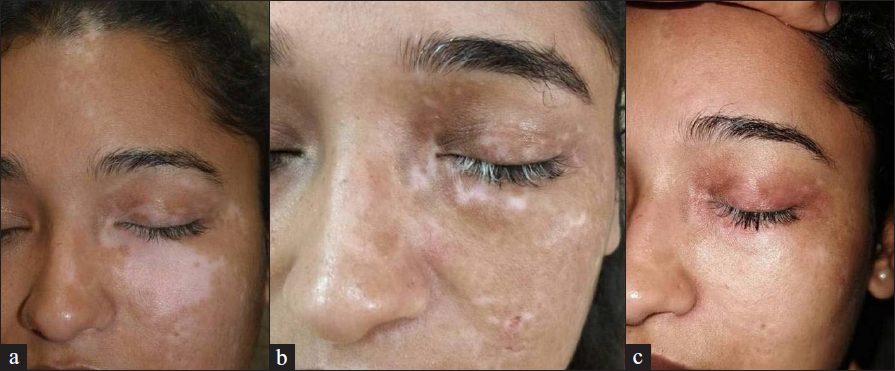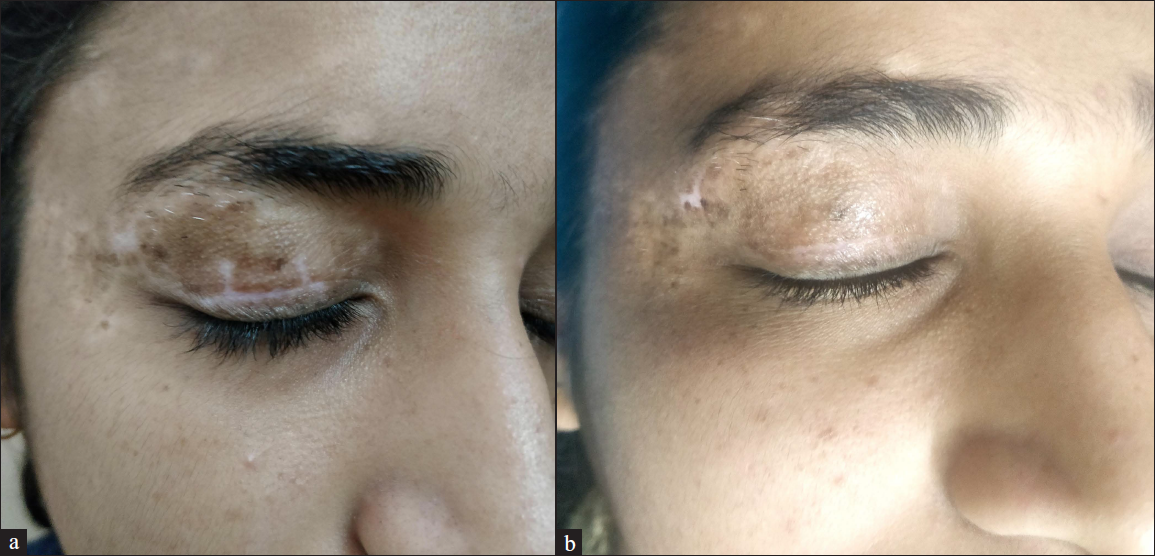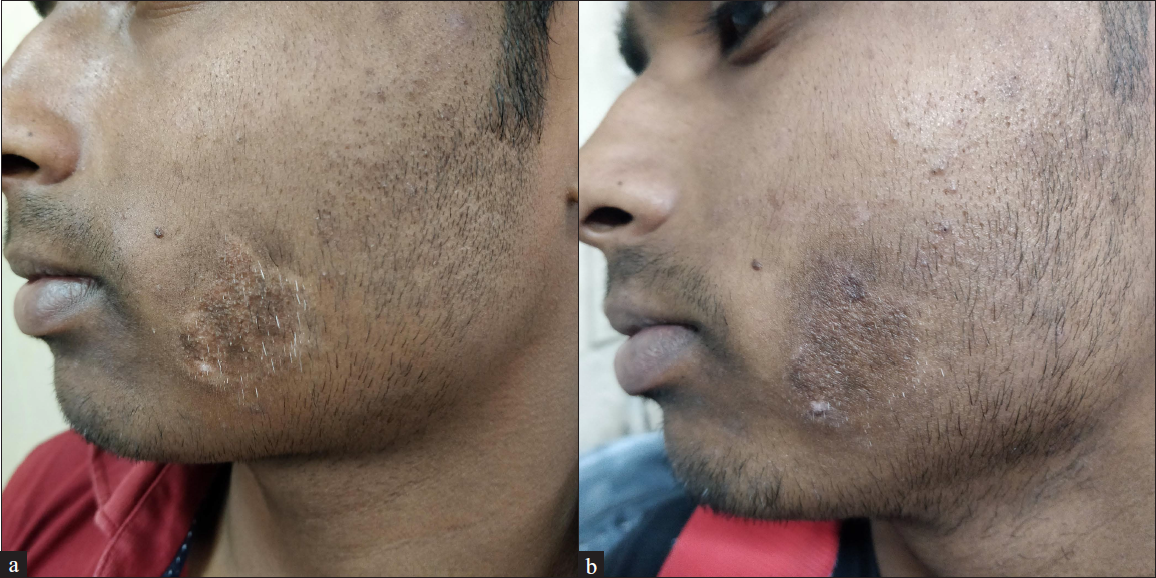Translate this page into:
Excimer light therapy for the treatment of residual depigmentation after at least six months of surgical grafting techniques in stable vitiligo: Results of a retrospective case series
-
Received: ,
Accepted: ,
How to cite this article: Yadav D, Gupta S. Excimer light therapy for the treatment of residual depigmentation after at least six months of surgical grafting techniques in stable vitiligo: Results of a retrospective case series. Indian J Dermatol Venereol Leprol 2022;88:671-4.
Sir,
Repigmentation is often incomplete after various surgical grafting techniques in vitiligo due to inadequate pigment dispersion. Treatment of these residual depigmented areas is challenging, often requiring repeat surgical intervention.1 Early use of excimer therapy in the post-surgical period have been found to be beneficial. However, there is a lack of data on its efficacy in patches remaining long after surgery. We undertook a retrospective review of the efficacy of excimer light for residual depigmented patches remaining after at least six months of surgical grafting techniques in stable vitiligo. A total of 22 cases were included with mean age of 22.7 years, male: female ratio of 1:4.5 and had undergone transplantation surgery at least before six months [Table 1]. The majority of the cases had segmental vitiligo (14 cases, 63.6%) with mean duration of illness of 6.4 years and skin phototype IV–V. The last surgical interventions included both cellular (non-cultured epidermal cell suspension: 11 cases; non-cultured epidermal cell suspension with extracted hair follicle outer root sheath cell suspension: six cases) and tissue (suction blister graft: three cases; punch graft: two cases) grafting methods. The mean duration since the last surgical intervention was 10.1 ± 5.2 months. All cases had received an adequate trial of medical management including phototherapy prior to surgical intervention. In the post-surgery period, they were advised tacrolimus 0.1% ointment once-daily application and daily sun exposure for at least ten minutes, starting one to three weeks after surgery. The excimer light was given using a hand-held xenon chloride lamp (Excipelx®, Clarteis, Valbonne, France) two to three times per week on non-consecutive days. The initial dose given was based on the site involved (head and neck: 100 mJ/cm2, trunk: 150 mJ/cm2, upper limb: 200 mJ/cm2, lower limb: 200 mJ/cm) with increment by 50 mJ depending on the erythema at 48 hours. Tacrolimus 0.1% ointment and fluocinolone acetonide 0.1% cream were given concomitantly in 20 and one case respectively. The mean number of sessions received were 23.7 ± 10.3, cases who had received less than ten sessions of excimer therapy were excluded. Efficacy was measured as patient and investigator global assessment (subjective based on the photographic review, single-blinded observer), in terms of percentage improvement from baseline. The mean ± SD percentage improvement on patient global assessment and investigator global assessment were 27.6 ± 28.6 (range: 0–90%) and 27.6 ± 29.2 (range: 0–90%), respectively [Figure 1a–c] [Table 1]. On the evaluation of site-wise treatment response, facial lesions (n = 12) showed the maximum improvement with mean improvement of 37.5% ± 27.1% and 38.3% ± 27% on patient and investigator assessment, respectively [Figures 2a-b and 3a-b] [Table 1]. Post-treatment hyperpigmentation was seen in one case. No other major side effects were noted.
| Parameters | Mean ± standard deviation/median (range) |
|---|---|
| Total cases | Included: 22 Excluded: 4 (<10 sessions of excimer light therapy) |
| Age | 22.7 ± 4.7 years |
| Male: female | 1:4.5 |
| Type of vitiligo | Segmental: 14 (63.6%) Non-segmental (acrofacial 5, vulgaris 1): 6 (27.3%) Mixed: 1 (4.5%) Focal: 1 (4.5%) |
| Total disease duration | 6.4 ± 2.5 years |
| Skin phototype | IV: 7 (31.8%) V: 15 (68.2%) |
| Sites involved | Face: 12 Upper limbs: 1 Lower limbs: 3 Trunk: 5 Acral sites: 4 |
| Previous surgical treatment | Non-cultured epidermal cell suspension: 11 (50%) Non-cultured extracted hair follicle outer root sheath cell suspension: 6 (27.3%) Suction blister grafting: 3 (13.6%) Punch grafting: 2 (9.1%) |
| Duration since last surgery | 10.1 ± 5.2 months |
| Concomitant therapy | Tacrolimus: 19 Fluocinolone: 1 Tacrolimus + fluocinolone: 1 No treatment: 1 |
| No. of excimer sessions | 23.7 ± 10.3 (10–42) |
| Dose of excimer (median, range) | Face: 750 (250–1100) Upper limbs: 450 Lower limbs: 1050 (750–1500) Trunk: 550 (300–1000) Acral sites: 700 (500–1000) |
| Patient assessment | Global: 27.6 ± 28.6 (0–90%) Face: 37.5 ± 27.1 (0–90%) Upper limbs: 0 Lower limbs: 16.6 ± 23.4 (0–50%) Trunk: 24 ± 28 (10–80%) Acral sites: 0 |
| Physician assessment | Global: 27.6 ± 29.2 (0–90%) Face: 38.3 ± 27 (0–90%) Upper limbs: 0 Lower limbs: 20 ± 28.2 (0–60%) Trunk: 20 ± 20.5 (0–70%) Acral sites: 0 |

- (a) Segmental vitiligo before surgical intervention. (b) Residual depigmented areas 12 months after non-cultured epidermal cell suspension (c) A >50% repigmentation after 35 sessions of excimer light therapy

- (a) Residual depigmented area 10 months after non-cultured epidermal cell suspension. (b) >50% repigmentation after 42 sessions of excimer light therapy

- (a) Residual depigmented area 12 months after suction blister grafting. (b) A <50% repigmentation after 20 sessions of excimer light therapy
Incomplete repigmentation is often encountered after transplantation surgery for vitiligo. Various causes include contraction or displacement of graft, incomplete dermabrasion of recipient site, inadequate dispersion of cellular graft material, insufficient pigment dispersion and autoimmunity.1,2 Such residual depigmented areas also known as achromic fissures are difficult to manage and often demand repetition of surgical procedures. Targeted phototherapy in the form of excimer therapy has been found to be effective in achieving greater pigmentation when combined with surgical grafting techniques.3 In addition, excimer therapy reduces the odds of developing perigraft halo or achromic fissures.4 The results were similar when compared to narrowband ultraviolet B light therapy.5 However, in all these studies excimer therapy was given early in the course of treatment, usually within one to two weeks after the surgery.3-5 As far as ascertained, no study evaluated the role of excimer therapy for residual depigmented lesions long after the surgical procedure. We tried excimer light for the management of such lesions remaining after six months or more since the last surgical procedure, who had received an adequate trial of non-targeted phototherapy (psoralen and ultraviolet A or narrow-band ultraviolet B) prior to surgical intervention. Around half of these cases (ten cases, 45.4%) had undergone surgical intervention more than once in the past. Though we find less than 30% overall response, excimer therapy did induce good pigmentation (>50% repigmentation) in seven cases (31.2%) leading to acceptable cosmetic results along with reducing morbidity associated with repeat surgical intervention. The repeat surgical intervention could be avoided in four cases. Of note, lesions on acral sites (hands and feet) showed minimal improvement. Sheth et al. found a median improvement of 9% with excimer light combined with punch grafting in acral vitiligo.6 Excimer lamp is a good and convenient tool for the localised area of depigmentation. It delivers the desired energy in a quick time and is patient-friendly. Results with excimer light are comparable with phototherapy in the early postoperative period. However, there is a lack of literature on the comparison between the two modalities in the late post-surgical phase. The rationale of using excimer light at least six months after the last surgical intervention in the present study was to see if it could induce pigmentation and prevent the need for re-surgery. In conclusion, late therapy (at least six months after surgery) with excimer light was not effective in the majority of our cases, repeat surgery could be avoided in only four cases. However, future long term prospective studies are needed to determine its efficacy and also compare with other modalities like ultraviolet B phototherapy. Our study had various limitations including small sample size, retrospective nature and lack of control group.
Declaration of patient consent
The authors certify that they have obtained all appropriate patient consent.
Financial support and sponsorship
Nil.
Conflicts of interest
There are no conflicts of interest.
References
- Tissue grafts in vitiligo surgery - past, present, and future. Indian J Dermatol. 2009;54:150-8.
- [CrossRef] [PubMed] [PubMed Central] [Google Scholar]
- Autoimmune destruction of skin melanocytes by perilesional T cells from vitiligo patients. J Invest Dermatol. 2009;129:2220-32.
- [CrossRef] [PubMed] [Google Scholar]
- The additive effect of excimer laser on non-cultured melanocyte-keratinocyte transplantation for the treatment of vitiligo: a clinical trial in an Iranian population. J Eur Acad Dermatol Venereol. 2015;29:745-51.
- [CrossRef] [PubMed] [Google Scholar]
- Long-term results of split-skin grafting in combination with excimer laser for stable vitiligo. Dermatol Surg. 2010;36:499-505.
- [CrossRef] [PubMed] [Google Scholar]
- A randomized comparison of excimer laser versus narrow-band ultraviolet B phototherapy after punch grafting in stable vitiligo patients. J Eur Acad Dermatol Venereol. 2012;26:690-5.
- [CrossRef] [PubMed] [Google Scholar]
- Efficacy of narrowband ultraviolet B versus excimer radiation in repigmenting vitiligo after minigrafting on the distal arms. J Am Acad Dermatol. 2012;67:318-20.
- [CrossRef] [PubMed] [Google Scholar]





